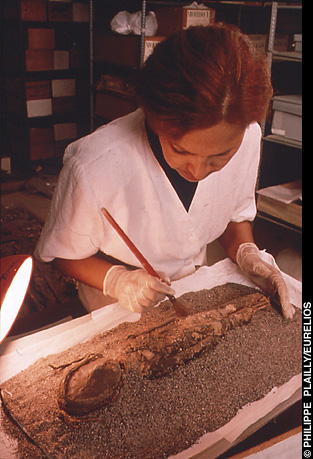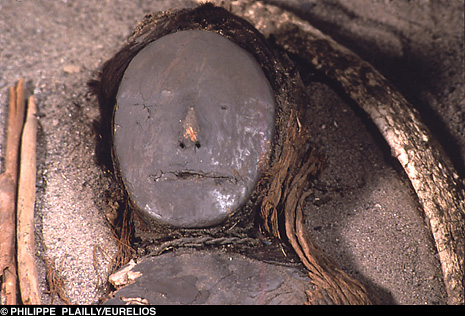An indication of
affection as a motive for mummification is the amount of resources and temporal
investment involved in the process. The Chinchorro mummies, dating from as early as 7810 BP, are an example. These
meticulously treated and preserved bodies, found in the Atacama Desert region of South America, are
among the oldest known artificially created mummies in the world (Guillen,
2004). There are at least two distinct types of mummies found from this culture,
called Red style and Black style. The former had the skin opened to remove
muscle and internal organs, and were then stuffed with reeds, clay, and other
materials. A clay mask was then shaped with its eyes and mouth open, perhaps to
assist the soul in returning to the body or indicative of interaction with the
deceased such as talking to them or feeding them (Arriaza, Hapke & Standen,
1998). They would then be fitted with a long wig of human hair. The Black style
mummies were more complex, and were created by disarticulating the body and removing all the soft tissue before forming clay and
other materials around the skeleton. The skin was then fitted over this shape
and a short, human hair wig was placed on the head. A black clay mask was also
present, with small slits to represent the eyes and mouth.
 |
| Examining an infant preserved in Black Style. |
The sheer amount
of work required to preserve bodies in this way indicates a reverence and
respect for the dead, as well as an integration of the dead into the world of
the living. This integration would have been literal in terms of the time and
effort needed to treat the bodies, and may also have been representative of the
individual’s continued agency in their
society (Dillehay, 2012). Among the Black mummies, most of the recovered bodies
were infants and young children, which suggests an element of grieving was
involved in the decision to mummify their remains. The later Red mummies
represented a wider range of ages, but several infants were also found. While
many bodies were found which had been naturally mummified, all the infants
recovered were artificially preserved while only some adults were given the
treatment. This is hypothesized to be an ideological trend, since it is present in bodies recovered from a variety of
times and contexts, and could be explained as a representation of the
individual’s continued social presence after their physical death (Arriaza et
al, 2005; Dillehay, 2012).
Many of the
mummies recovered from Chinchorro sites displayed signs of having been
re-painted or repaired. This evidence suggests that the mummified effigies of
individuals were likely displayed for quite some time after their death,
potentially serving a spiritual or social role, before being buried in small
groups of four to six individuals which may have been family groups (Arriaza,
Hapke, & Standen, 1998). The long-term upkeep of the bodies before their
eventual burials indicates that the connection between the living and the
deceased is not severed by physical death, and that they continue to play an
important role in the family and community.
 |
| The Black style mummy of an adult woman. © Philippe Plailly/EURELIOS |
-Dylyn Wilkinson

No comments:
Post a Comment